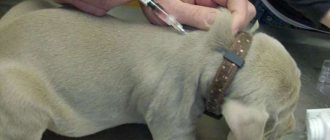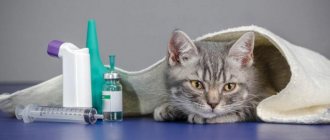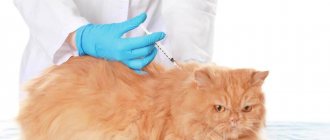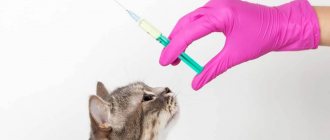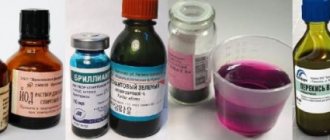Recommendations for choosing a syringe for injecting a cat. Step-by-step techniques for injecting medicine into the withers and muscles of a cat.
A person lives in society. And these are not only people, but also living nature.
Animals, perhaps, have always been man’s companions, lived next to him and filled his days with special emotions.
Nowadays, we breed and care for pets. Just like people, they get sick and need care and treatment.
Therefore, owners of cats and kittens master the technique of administering medicine to them with a syringe. Even if for the first time it is associated with excitement and uncertainty in your movements, the thought that you are helping your pet recover gives strength and firmness to the movements.
Let's talk in more detail about the technique of giving cats injections into the muscle and under the skin.
What syringe should I use to inject a cat?
insulin syringes are a good choice for subcutaneous injections in a cat.
A cat’s body is several times smaller than a human’s. Therefore, the doses of medications prescribed for injection are also minimal.
Depending on where they are inserted, use a syringe:
- insulin
- for 2-3 cubes
Use the first for injections in the withers, or subcutaneously, of the cat, and the second - in the thigh, or intramuscularly.
- If the thickness of the syringe needle is large, replace it with another one with a smaller diameter.
- Be sure to unpack a new syringe before injecting medication into your cat.
- An acceptable option is when you immediately prepare a solution from one bottle of dry powder and draw the required doses into several new syringes. In this case, store them in the refrigerator with the caps on the needles.
- Never touch the needle of a syringe you are about to inject into an animal.
The appearance of abscesses
Swelling and ulcers after injection can only appear if you performed this procedure incorrectly. A dangerous microorganism or bacterium penetrates into a small wound, resulting in an infection, accompanied in most cases by tissue inflammation.
The swelling may go away on its own after some time. If this does not happen, then an abscess forms, they are already removed through surgery, after the operation the veterinarian prescribes a course of anti-inflammatory drugs.
How to correctly give a subcutaneous injection to a cat, kitten, cat at the withers: technique, photo
a woman strokes a cat to calm it down before an injection in the withers.
Subcutaneous administration of a liquid, non-oily medicine to a cat is performed in 2 ways:
- at the withers
- fold under the knee
We will focus on the first method, which is also good for giving “painful” injections to an animal.
To do this, proceed as follows:
- wash your hands
- take out the medicine and warm it in your palm if it was stored in the refrigerator
- check the expiration date indicated on the ampoule/packaging
- unpack the syringe
- if the veterinarian has prescribed injections for an animal using several drugs at the same time, mix them according to the prescription
- take the required amount of medicine
- lift the syringe vertically with the needle up and lightly press the plunger to release air bubbles
- cast aside all doubts and worries, calm down
- talk kindly to your pet, pet it, calm it down
- fix the cat with your left forearm
- With the fingers of your left hand, pull up the skin between the animal’s shoulder blades
- bring your right hand with the syringe closer to its base
- select the direction of needle insertion parallel to the cat's spine with an inclination of 45°
- pierce the skin and move deeper another 1-1.5 cm
- you will feel resistance, but once the needle reaches the desired depth under the skin, it will disappear
- press the plunger of the syringe and slowly inject the medicine
- if not all the air has come out of the syringe before the injection, leave a few drops of the medicine
- carefully remove the needle and release the cat's skin
- pet her and say something kindly
Let's add a video for clarity.
Complications and what to do about them
There are several reasons that can cause complications. Depends on various factors, for example:
- Neglecting the rules of asepsis and antisepsis may result in a lump or abscess at the injection site. This is due to the development of an inflammatory process in tissues.
- If oil solutions enter the vessels, it results in a fat embolism, that is, blockage of the lumen of a vein or artery, which leads to problems in the circulatory system and is one of the most serious complications.
- When an irritating substance penetrates the connective tissue, abscesses, inflammatory compactions, cell death and sarcomas (malignant neoplasms in soft tissues) are formed.
- Administration of products that have expired or are of poor quality, as well as the development of hypersensitivity to the drug, which may result in allergic reactions.
- Using a cold solution (especially an oily one) can cause sarcomas and inflammatory lumps to form.
Therapeutic tactics depend not only on the cause of the complications, but also on its type.
The most common are:
- Lameness. It often develops after intramuscular injections carried out according to all the rules, and goes away on its own within 24 hours. It can also be triggered by inadequate therapy (independent treatment without specialist prescriptions), so Drotaverine (No-shpa) is contraindicated for administration to cats.
- Blood after an injection. Appears frequently and is associated with puncturing a capillary with a needle. In case of prolonged bleeding (more than 20 minutes), you need to apply ice to the injection site and take the cat to a veterinary clinic. This complication indicates that a vessel of larger diameter has entered a vessel.
- Infiltration (subcutaneous compaction). If it does not resolve on its own within 5 days, you need to apply dry heat. For example, pour salt or sand into a canvas bag, heat it and apply it to the seal for 10-15 minutes daily. Due to increased blood circulation, the infiltrate gradually resolves. If it begins to enlarge or itching appears in this area, the procedures should be stopped and a veterinarian should be consulted.
- Abscess and phlegmon. This is a purulent inflammation of tissue. They are accompanied by symptoms: an increase in local (at the injection site) temperature, an increase in the volume of swelling and its softening in the center after 1-2 days, the appearance of pain when palpated. At the same time, the general condition of the pet changes. He refuses to drink or eat, appears lethargic, and stops playing. This is one of the most serious complications that requires immediate medical attention. Treating a cat on your own is dangerous for its health. If the process of pus formation has just begun, physiotherapy can help, but in more advanced cases, the lesion is opened and sanitized, that is, cleansed.
If after the injection the pet’s behavior changes, a lump appears at the injection site and other symptoms, it is better to show the cat to a specialist in order to provide the necessary assistance in a timely manner and not start the process that has begun.
Intramuscular injection into the thigh of a cat, kitten, cat: technique
the veterinarian gives an injection to the kitten in the thigh.
For this method of administering medicine to the cat, invite an assistant who will hold the animal and fix it in one place.
Then proceed like this:
- prepare yourself, the syringe, the medicine and the cat as described in the previous section,
- decide on the place where the manipulation will be performed - it should be a hard surface, for example, a table or floor,
- position the cat with its tail towards you and ask a helper to hold it and its back paw,
- try the softest place on it with your fingers, the muscle should be relaxed,
- if there is tension, massage the muscle slightly and slightly bend the animal’s paw if it has been fully straightened,
- select the softest place and move the needle so that it is parallel to the insertion surface,
- At the most acute angle, confidently insert the needle with a firm hand movement,
- deepen it 1 cm,
- administer the medicine slowly
- remove the syringe needle,
- release the cat.
Remember that an injection in the thigh is painful for the animal. Therefore, there should be no delays or gentle movements when performing it.
If your veterinarian has prescribed a course of injections for your cat, alternate paws to give the puncture site time to heal.
So, we looked at the features of giving injections to cats with different syringes in the withers and thigh. We also studied the technique using videos and photos.
Remember, love for an animal is expressed not only in joint games and fun, but also in caring for it during illness.
Therefore, feel sorry for your cat rationally - give the injection safely if it was prescribed by the doctor.
For a detailed description of the technique for performing an injection on a cat, watch the video below.
Rate of drug administration
It depends on the volume of the medicine, as well as on its thickness. Aqueous solutions are injected at an average rate of 1 ml per 1 second, and oily or viscous solutions - the same volume in 5-7 seconds.
If all the instructions presented are difficult for you to perceive in text form, then you can watch a video on how to give an injection to a cat.
Calm your pet
Many people wonder how to administer an injection without much effort if the cat has a fighting character and is ready to do anything to dodge. The first thing you should do is monitor your behavior: if you are very excited and afraid of doing something wrong, the same mood will be transmitted to your kitten.
Try to tune in to a positive train of thought and act clearly, without delay, without leaving the cat a single chance of resistance.
When should you contact your healthcare provider?
Call your healthcare provider if you have the following symptoms:
- Blood does not stop flowing from the injection site.
- You have very severe pain.
- You injected the medicine into the wrong place.
- You have a fever of 100.4°F (38°C) or higher.
- You have signs of an allergic reaction, such as swelling, redness, itching, or a rash.
- You cannot use the syringe because the medicine has expired, the medicine has foamed, changed color, become cloudy, or has crystals in it.
- You cannot use the syringe because you touched something with the needle before injecting.
- You cannot use a pre-filled syringe with Lovenox because there is no air bubble in it.
- You are having difficulty administering the injection.
to come back to the beginning
How to Store Prefilled Syringes
How you store prefilled syringes depends on the type of medicine in them. Most medications are stored at room temperature, but some should be kept in the refrigerator. Your healthcare provider will tell you how to store your syringes. Do not store prefilled syringes in the freezer or leave them in the sun.
Check one of the boxes below so you don't forget how to store your syringes.
- Store prefilled syringes at room temperature.
- Store prefilled syringes in the refrigerator.
If you have questions about storing or carrying prefilled syringes while traveling, contact your healthcare provider.
What to do if the medicine is frozen
If the medicine inside the syringe is frozen, place it near the front of the refrigerator or on a shelf in the refrigerator door to thaw. Do not use the medicine if it has been frozen more than once. Call your healthcare provider for further instructions.
to come back to the beginning
